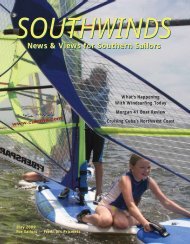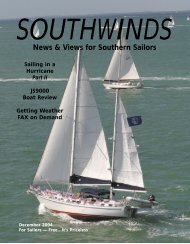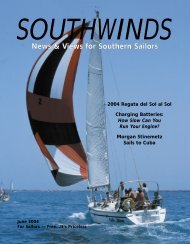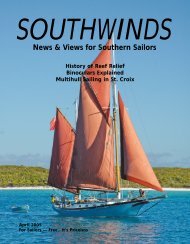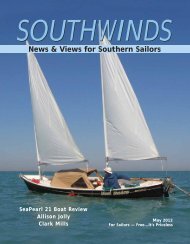Gulf StreamCrossingsBy Rebecca Burg“We hit something,” Terry said, smackingone hand into the other. “Bang!” Terrygoes on to describe a recent Gulf Streamcrossing with her husband, Captain Ron,and pet poodle, Ocean, on their 36-footGulfstream trawler, Silk Purse IV.Every year, thousands of boats cross the Gulf Streambetween Florida and the Bahamas. A well-worn trail, it’san easy hop when the weather is right. However, whenthe wind picks up and shifts against the current or squallsstart rearing their cloudy heads, a Gulf Stream crossing canbe dangerous.Boaters may also encounter fast-moving freighters,unlit vessels at night or unseen obstacles floating in thewater. Silk Purse had encountered the latter. It was earlysummer when the trawler had left the north end of KeyBiscayne, near Miami, FL, and headed toward Bimini,Bahamas. It was 4 a.m. Experienced cruisers, they’d waited<strong>for</strong> a good weather window and faced less than three-footseas. In the dim gray light of dawn, Silk Purse hit something.The trawler shuddered as she glanced off a submergedobstacle. Quick-thinking, Ron threw the engine into neutralwhile Terry scurried <strong>for</strong>ward. Pushed into motion by SilkPurse, a large tree bobbed upright, then began tumbling endover end. The trawler fell away. Wide-eyed, Terry watchedas the tree’s massive, knarled root ball careened over SilkPurse’s bow. Just missing the boat’s rail, the sodden tree vanishedback into the inky water. Undamaged, the luckytrawler was able to continue her journey. With no furthersurpises, they arrived in Bimini by lunchtime after a 47-nautical-milecrossing.Waiting <strong>for</strong> good weather, the number of boats in FortLauderdale, FL, grew. By Easter weekend, the windowopened. Escape, a Hunter 290 sloop, bounced and rocked herway through a crazed crowd of weekend warriors, fishingvessels and fellow Bahamas-bound cruisers. It was only2:30 a.m. Cruising couple Tom and Babette brought Escapeinto calmer seas after skirting a long line of waiting cruiseships. The conditions were so calm that the sailboatmotored to West End, Bahamas. “I would’ve liked a littlewind,” Tom admits, but he was glad to finally resume theirtrip and appreciated its uneventful nature. “The roughestpart of the whole thing was getting through the crowds atFort Lauderdale!” Babette said. With a 70-nautical-mile hop,an early start and fair skies ahead, Escape traveled at a fuelconservativepace and reached West End near 3:30 p.m.Their travel time was 13 hours.Dennis, a long-time sailboat owner, had recentlybought Island Dream, a trawler. He says he was still thinkinglike a sailor on his most recent Gulf Stream crossing thisJune. With wife Sharon and crewmember Bob, Dennis tookIsland Dream out of Jupiter, FL, at 5:00 p.m. <strong>for</strong> an overnightcrossing to West End. With years of sailing experience, itwas a routine trip <strong>for</strong> Dennis. However, he was still gettingused to his new power vessel’s different handling characteristics.The weather <strong>for</strong>ecast showed nothing alarming. Yet,midway in the trip, a rapidly developing low-pressure area<strong>for</strong>med over Island Dream. In the dark of the night, squallswhipped the waves into a dangerous jumble. Easterlywinds gusted to 50 mph, and the growing seas were estimatedto be near 12 to 14 feet. About 30 nautical miles offshore,the trawler struggled to make headway. “At thattime, we were only traveling half a knot,” Bob says.Forward progress became extremely difficult, andDennis turned around to make a quick downwind slide tosafety. Back in Florida, Island Dream waited <strong>for</strong> better weatherto resume her travels, this time by day, and arrived atWest End after covering 60 nautical miles in an easy 10hours.Dick and Carol Simmons have been crossing the streamevery year since 1964 in both power and sailing vessels.Currently, they cruise in Gusto!!!, an Island Packet 44, andthey recall their most memorable experience. It was earlyfall in the mid-’90s, and they left Port Lucaya, Bahamas, <strong>for</strong>40 October 2006 SOUTHWINDS www.southwindsmagazine.com
an 80-nautical-mile crossingto Boca Raton, FL. Itwas an overnight tripwith a favorable <strong>for</strong>ecast.There was no wind; theseas were flat. After ashort time, the windslowly began to build,and the sailboat rushedalong on a broad reach.Dick and Carol becamealarmed when the windscontinued to increase to20 knots—then to 30 andbeyond. The seas becameso steep that a nearbyfreighter completely disappearedfrom viewwhenever it fell into awave’s trough. “That wasthe scariest,” Dick said,also noting that badweather at night always seems intensified. “It’s hard to seewhat’s coming at you,” he says. After a long, difficult sail,the couple made it to Boca Raton after daybreak. Despitethat one incident and the many years making crossings,Dick and Carol have had few negative experiences due tocareful weather watching and sensible planning.Boats coming from the Gulf of Mexico will usually betraveling up the Keys be<strong>for</strong>e making the jump to theBahamas. Two single-handed sailboats traveling from thisdirection, Defiant and Angel, were sailing together <strong>for</strong> safetyand company. On their most recent crossing in spring, theyleft a far southerly anchorage in Key Largo, near RockHarbor, at 6:45 a.m. with a favorable <strong>for</strong>ecast of southeastwinds. The expected winds never materialized, and bothsailboats motored 77 nautical miles to Bimini, Bahamas.Both boats saw 1- to 2-foot seas. Lacking any resistance fromwind or wave, they used the stream’s current to increasetheir motoring speed. Reaching Bimini at 5:30 p.m., traveltime was almost 11 hours. Angel’s average motoring speedis normally 5 knots, yet her progress, speed over ground,increased to speeds of up to 8.9 knots in the middle of theGulf Stream where its current flows the strongest.Calm weather windows are perfect <strong>for</strong> the cruisingtrawler while sailboaters hope <strong>for</strong> breezes of up to 15 knots.As expected, sailors prefer to sail across the stream, butthose with reliable engines were not hesitant to take advantageof any good weather window, including calms.Seasoned cruisers say they will avoid leaving if the windsare over 15 knots. Of course, as Gusto!!! and Island Dreamhad experienced, unexpected weather can catch a vessel inthe open. Though merely coincidence, both of these vesselshad been traveling at night, when changing skies andoncoming weather is less visible.Also, boaters will avoid crossing the Gulf Stream whenthe winds have any component of north in them. Naturally,northerly winds go against the stream’s current as it flowsfrom the south, and this builds steep and dangerous seas.The most common jump-off points to the Bahamas, (usuallyto West End or Bimini), are between Key Largo and WestPalm Beach, FL. Anything farther north and a vessel is<strong>for</strong>ced to travel against the current, an uncom<strong>for</strong>table andDefiant motoring in the middle of the Gulf Stream on a calm day.uneconomical ride. Daytime or night crossings are a matterof personal choice and level of experience. Slower vesselswill usually plan crossings overnight so they can arrive inthe Bahamas with lots of daylight to spare, enabling them tosee shallow water and unlighted channels. It’s a matter ofcareful planning, plotting and weather watching.<strong>News</strong> & <strong>Views</strong> <strong>for</strong> <strong>Southern</strong> <strong>Sailors</strong> SOUTHWINDS October 2006 41



